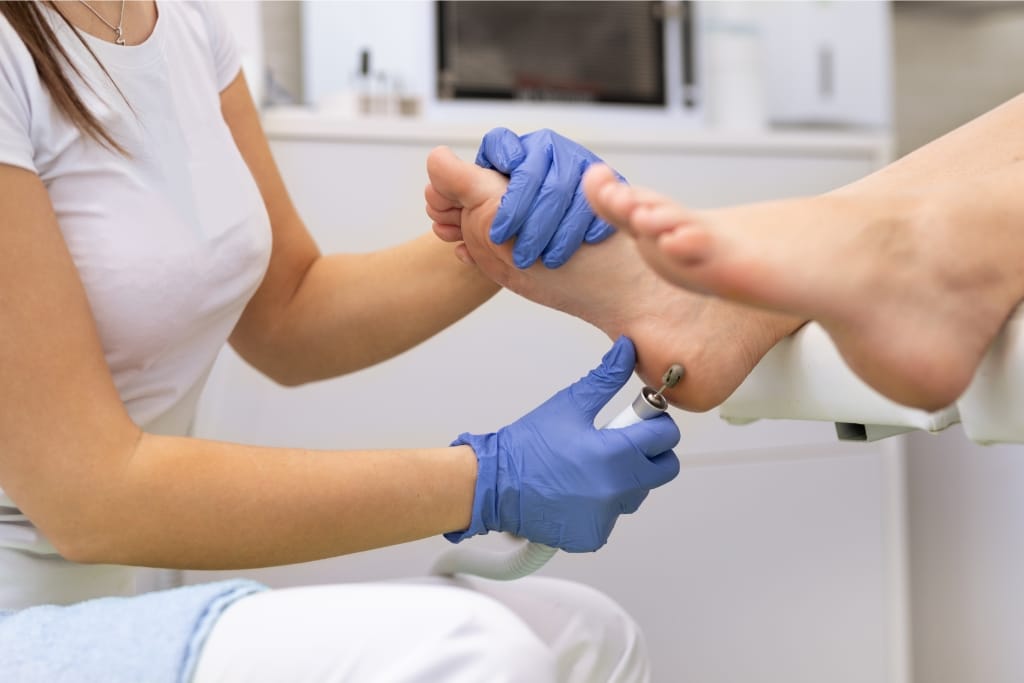Foot problems are common among people with diabetes, as the condition can damage the nerves and blood vessels in the feet.
The gradual reduction of blood flow and loss of sensation increase the risk of ulcers and infections and can ultimately lead to amputation.
Fortunately, diabetic foot problems are largely preventable with proper care and attention.
Here are 10 important tips that can help keep your feet healthy and protect them from potential complications.
1)) Keep Your Blood Sugar Levels In Check
High blood sugar levels can damage various organs in the body, including nerves and blood vessels in the feet.
By keeping your blood glucose levels under control, you can reduce the risk of nerve damage, poor circulation, and infections that may lead to serious foot problems.
Additional Tips To Manage Your Blood Sugar Levels:
- Monitor Regularly: Check your blood sugar levels regularly with a high-quality blood glucose monitor to understand how your diet, physical activity, and medication affect them. This can help you make necessary adjustments to your routine or treatment plan.
- Maintain a Healthy Diet: Incorporate a balance of proteins, fats, and carbohydrates in your meals. Avoid processed foods and high-sugar snacks, opting for fresh fruits and vegetables instead.
- Stay Active: Regular physical exercise can help regulate your blood sugar levels. Try to include at least 30 minutes of moderate activity, like walking or cycling, into your daily routine.
- Take Medication As Directed: If you've been prescribed medication for diabetes, make sure to take it as directed by your healthcare provider. Skipping doses or changing dosage can affect your blood sugar levels.
- Schedule Regular Check-ups: Regular appointments with your healthcare provider can help monitor any changes in your blood sugar levels and adjust the treatment plan if needed.
Managing your blood sugar levels is a vital aspect of diabetic foot care.
By taking proactive measures such as regular monitoring, maintaining a balanced diet, staying physically active, adhering to medication regimens, and scheduling consistent healthcare check-ups, you can significantly reduce the risk of foot complications.
Effective diabetes management is the first line of defense against foot problems.
2)) Inspect Your Feet Daily
Check your feet every day for blisters, cuts, sores, or other signs of infection, especially if you have reduced sensation in the feet.
Use a mirror or ask for help to inspect the bottom and sides of your feet if you can’t see them.
Practical Steps To Efficiently Inspect Your Feet Daily:
- Use a Mirror: Using a mirror can help you see the bottom and sides of your feet. This will help in spotting any abnormalities or signs of infection that you might miss otherwise.
- Feel Your Feet: Use your hands to feel for any swellings, bumps, or warmth - these could be signs of infection or inflammation.
- Look for Changes: Pay attention to changes in color, shape, or size of any bumps, blisters, or sores. Any noticeable change should be reported to your healthcare provider.
- Check Your Toenails: Also inspect your toenails for any signs of fungal infections, such as discoloration or thickening of the nails.
- Ask for Help: If you find it difficult to inspect your feet by yourself, don't hesitate to ask for help from a family member or a healthcare provider.
Conducting daily inspections of your feet is a crucial step in preventative diabetic foot care.
Through the use of tools like a mirror and the assistance of others, if required, you can effectively monitor for changes or signs of potential issues.
Regularly feeling your feet and watching for changes in the condition of your toenails can also help spot infections early.
By staying vigilant and proactive, you can address any issues promptly, reducing the risk of serious complications.
3)) Wash Your Feet Regularly
Wash your feet daily with lukewarm water and mild soap. Avoid hot water and direct contact between your feet and the water source to prevent skin injuries.
Be sure to dry your feet well, especially between the toes.
Essential Steps To Follow When Washing Your Feet Regularly:
- Use Mild Soap: Always opt for mild soap or a diabetic foot wash when washing your feet. Harsh soaps can strip your skin of natural oils, leading to dryness and irritation.
- Lukewarm Water is Best: Avoid using hot water as it can damage your skin. Instead, use lukewarm water, which is gentle on your skin and less likely to cause burns.
- Avoid Direct Contact With Water Source: Never put your feet directly under the faucet or into a full basin before testing the water temperature with your hands first because of reduced sensitivity in your feet.
- Dry Your Feet Thoroughly: Take extra care to dry your feet thoroughly, especially between the toes, to prevent fungal infections.
- Moisturize: After washing and drying your feet, apply a good moisturizer to prevent dryness and cracking. However, avoid applying moisturizer in between your toes to prevent moist conditions that favor fungal growth.
Maintaining a regular foot hygiene regimen is an integral part of effective diabetic foot care.
Using mild soap and lukewarm water, avoiding direct contact with the water source, drying your feet thoroughly, and applying moisturizer (while avoiding the areas between your toes) are all crucial practices.
This routine, when performed daily, can help protect your feet from potential issues, and significantly reduce the risk of complications associated with diabetes.
4)) Moisturize Your Skin
Apply a moisturizing cream to your feet to keep the skin soft and prevent cracking and itching.
Do not apply cream between the toes, as it can promote fungal growth in the moist area.
Key Recommendations for Effective Skin Moisturizing:
- Choose the Right Moisturizer: Opt for a high-quality moisturizer designed for dry skin. Avoid those with fragrances or added dyes, which can be irritating.
- Apply Daily: Regularly moisturize your feet, especially after bathing when your skin is still damp. This helps to lock in moisture.
- Avoid the Toes: Don't apply moisturizer between your toes, as this can create a moist environment, which is conducive to fungal growth.
- Use Gentle Strokes: Apply the moisturizer using gentle strokes. Don’t rub it vigorously as it can irritate.
- Stay Hydrated: Drink plenty of water throughout the day. Hydration from the inside can help to keep your skin moisturized.
Moisturizing is an essential component of self-care, particularly for individuals with diabetes.
Through the correct selection of a moisturizer, daily application, avoidance of the areas between the toes, gentle application techniques, and maintaining proper hydration, you can ensure your skin remains soft, healthy, and protected.
Consistent skin care practices not only prevent dryness and cracking but also act as a safeguard against potential skin complications.
5)) Cut Your Toenails Properly
Trim your toenails straight across and file the edges gently to avoid sharp corners that can penetrate the skin, causing cuts and infections.
Best Practices for Cutting Your Toenails Properly:
- Trim Straight Across: Always cut your toenails straight across. Avoid curving the corners as it could lead to ingrown toenails.
- File the Edges: After trimming your nails, gently file the edges to smooth out any sharp or rough corners that could potentially harm your skin.
- Use the Right Tools: Invest in good quality, sharp nail clippers or manicure scissors and a fine-grit nail file. Dull or poor-quality tools can leave jagged edges or cause injury.
- Avoid Cutting Too Short: Keep your toenails at a moderate length, not too short, to prevent the risk of ingrown nails and skin injuries.
- Seek Professional Help if Needed: If you have difficulty seeing or reaching your toes, consider getting your nails trimmed by a healthcare provider or a foot care specialist to avoid any accidental injuries.
Adopting correct toenail-cutting techniques is crucial in minimizing complications such as infections and ingrown toenails, especially for individuals with diabetes.
By ensuring that nails are trimmed straight across, edges are filed smoothly, the proper tools are used, nails are not cut too short, and professional help when necessary, the risk of self-inflicted foot injuries can be significantly reduced.
Regular and careful toenail care is a key step to maintaining overall foot health.
6)) Wear Well-Fitting Shoes And Socks
Choose shoes made of breathable materials with ample room for your toes. Avoid high heels and pointy-toed shoes that squeeze the toes. Wear socks that fit well, don’t bunch up, and absorb sweat.
Essential Tips for Choosing Well-Fitting Shoes and Socks:
- Select Breathable Materials: Opt for shoes made from materials like leather or canvas that allow air circulation and help to keep your feet dry.
- Ensure Ample Toe Room: Choose shoes with a wide toe box to prevent squeezing or crowding of your toes.
- Avoid High Heels and Pointed Shoes: These types of shoes can put undue pressure on your feet and cause discomfort or injuries.
- Choose Properly Fitting Socks: Socks should fit well without bunching up in your shoes. They should also be able to absorb sweat to help keep your feet dry.
- Consider Special Diabetic Footwear: If appropriate, consider special diabetic shoes and socks that are designed to reduce pressure points and prevent skin breakdown.
Choosing the right footwear is a crucial aspect of foot care, especially for individuals with diabetes.
Ensuring shoes are made from breathable materials, providing ample room for the toes, and avoiding high heels and pointy shoes can significantly reduce foot discomfort and potential injuries.
Likewise, wearing properly fitting socks that can absorb sweat can keep the feet dry and healthy.
Diabetic-specific footwear can also be beneficial in providing extra protection.
These practices contribute to improved foot health, comfort, and overall well-being.
Pro-Tip: Investing in high-quality diabetic footwear can significantly improve foot health and comfort for individuals with diabetes. These specially designed shoes help prevent foot complications by providing extra support, accommodating orthotic inserts, and offering ample space to avoid pressure points. They also include non-binding uppers to reduce the risk of skin breakdown and seamless linings to protect sensitive feet. High-quality diabetic footwear plays a crucial role in maintaining foot health by offering a customized fit that regular shoes can't provide, making them a worthwhile investment for anyone managing diabetes.
7)) Protect Your Feet From Extreme Temperatures
Avoid walking barefoot or in shoes without socks on hot pavement or cold snow.
Test the water temperature before immersing your feet in hot water, and use a foot thermometer to monitor the temperature of your feet.
Tips for Protecting Your Feet from Extreme Temperatures:
- Avoid Barefoot Exposure: Never walk barefoot on hot pavement or cold snow. This can cause thermal burns or frostbite. Always wear suitable footwear.
- Test Water Temperature: Before immersing your feet in hot water, such as in a bath or hot tub, test the water temperature with your hand to ensure it's not too hot.
- Use a Foot Thermometer: Use a foot thermometer to monitor the temperature of your feet and ensure they are not exposed to extreme heat or cold.
- Wear Insulated Footwear in Cold Climates: To protect against cold weather, wear insulated footwear with thermal socks. This can help to keep your feet warm and prevent frostbite.
- Use Sunscreen in Hot Climates: In hot weather, use sunscreen on the tops of your feet to prevent sunburn. Even the feet can get sunburned.
Protection against extreme temperatures is an often overlooked, yet crucial aspect of foot care.
Ensuring your feet are never exposed to severe heat or cold, testing water temperature before foot immersion, monitoring foot temperature with the help of a foot thermometer, wearing insulated footwear in cold climates, and applying sunscreen in hot climates, are all practices that contribute to safeguarding your feet from temperature-related damage.
Being mindful of these factors can significantly contribute to overall foot health, particularly for individuals with diabetes or other conditions that may impact foot sensitivity.
8)) Exercise Regularly
Physical activity helps improve blood flow and strengthen muscles, which can reduce the risk of foot problems.
However, be sure to wear proper footwear and check your feet before and after exercising.
Essential Tips for Regular Exercise and Foot Care:
- Choose Appropriate Footwear for Exercise: Make sure to wear supportive and comfortable shoes specific to your activity to prevent injuries and ensure your feet are well-protected.
- Inspect Your Feet Before Exercise: Check your feet for any existing cuts, blisters, or sores before you start exercising to avoid exacerbating any problems.
- Cool Down and Check Your Feet Post-Exercise: After exercise, perform a cooldown session to assist blood circulation, and inspect your feet for any new injuries or issues.
- Stay Hydrated: Keep yourself hydrated during exercise to prevent dehydration which can lead to dry and cracked skin on your feet.
- Gradually Increase Your Activity Level: Start slow and gradually increase the intensity and duration of your workouts to prevent any foot or ankle strain.
Regular exercise plays a crucial role in maintaining robust foot health by improving blood flow and strengthening muscles, thus helping to mitigate the risk of foot problems.
Observing vital protocols such as wearing suitable footwear, conducting pre and post-exercise foot checks, staying hydrated, and gradually increasing activity levels can ensure safe and effective workouts.
The key to exercising regularly without compromising foot health lies in taking these necessary precautions and being mindful of your body's signals.
Pro-Tip: Exercise bikes serve as an excellent alternative to street bikes, particularly for individuals with diabetes. Their key advantage lies in the controlled environment they offer, eliminating the risks associated with outdoor cycling such as unpredictable weather conditions or road accidents. Additionally, exercise bikes allow for the adjustment of resistance levels, enabling users to customize their workouts and gradually build strength and stamina. This personalized approach to fitness accommodates the distinct needs of diabetics, who often require a carefully monitored exercise regimen. Moreover, the low-impact nature of stationary biking exerts less pressure on the feet, reducing the risk of foot-related complications, a common concern for people with diabetes.
9)) Attend Regular Foot Exams
Regular foot exams by a healthcare professional can help identify potential foot problems before they become serious.
It is recommended to have your feet and lower legs screened at least once a year.
Expert Recommendations for Regular Foot Exams:
- Schedule Routine Checkups: Make a habit of scheduling foot exams at least once a year. If you have a high-risk foot condition, consider getting checkups more frequently.
- Prepare for Your Appointment: Before your appointment, make a list of your symptoms, questions, and all medications and supplements you're currently taking.
- Choose The Right Specialist: It's advisable to seek out a podiatrist or a doctor experienced in foot health for your exams.
- Follow Through With Advice: Follow all advice and treatment plans your doctor provides during these exams.
- Be Proactive: Don’t wait for your regular checkup if you notice any abnormalities or experience discomfort. Book an appointment with your healthcare provider as soon as possible.
Regular foot exams are paramount in the early detection and treatment of potential foot problems.
Implementing a routine of annual check-ups, preparing adequately for each appointment, choosing the right specialist, adhering to their advice, and being proactive in seeking care when abnormalities arise, are all practices that contribute to optimal foot health.
Early detection through regular foot exams can make a significant difference in preventing and managing foot-related problems.
10)) Quit Smoking
Smoking increases the risk of foot problems by restricting blood flow and causing nerve damage.
Quitting smoking can help improve your overall health and reduce the risk of complications associated with diabetes.
Practical Steps to Quit Smoking for Better Foot Health:
- Set a Quit Date: Start your journey by setting a quit date and stick to it. This gives you a concrete goal to aim for.
- Seek Professional Help: Consider reaching out to healthcare professionals who can provide advice and resources to help you quit smoking.
- Identify Your Smoking Triggers: Understanding what prompts you to smoke can help you develop strategies to deal with those situations without resorting to smoking.
- Find Healthy Alternatives: Replace smoking with healthier habits such as exercise or a new hobby. This can help distract you from cravings.
- Build a Support Network: Involve your family and friends in your process of quitting. Their support and encouragement can make a big difference.
Smoking cessation is a critical step in promoting overall foot health and reducing the risk of complications, particularly for individuals with diabetes.
By setting a quit date, seeking professional help, identifying personal smoking triggers, substituting smoking with healthier alternatives, and fostering a supportive network, the journey to quit smoking becomes more manageable.
Every step taken towards quitting smoking is a stride towards better foot health and overall well-being.
Conclusion
Maintaining foot health is a multi-faceted task that requires consistent effort and attention.
Regular exercise, routine foot exams, and putting an end to detrimental habits like smoking are just a few key aspects of preserving foot health.
The tips and strategies outlined in this article, ranging from the proper choice of footwear to the importance of hydration and regular checkups, aim to provide an actionable guideline for individuals to follow.
Your feet carry you through life's journey, so it's crucial to take good care of them.
By implementing these strategies, you can ensure your feet stay healthy and strong for years to come.
Download Our Free E-book!








